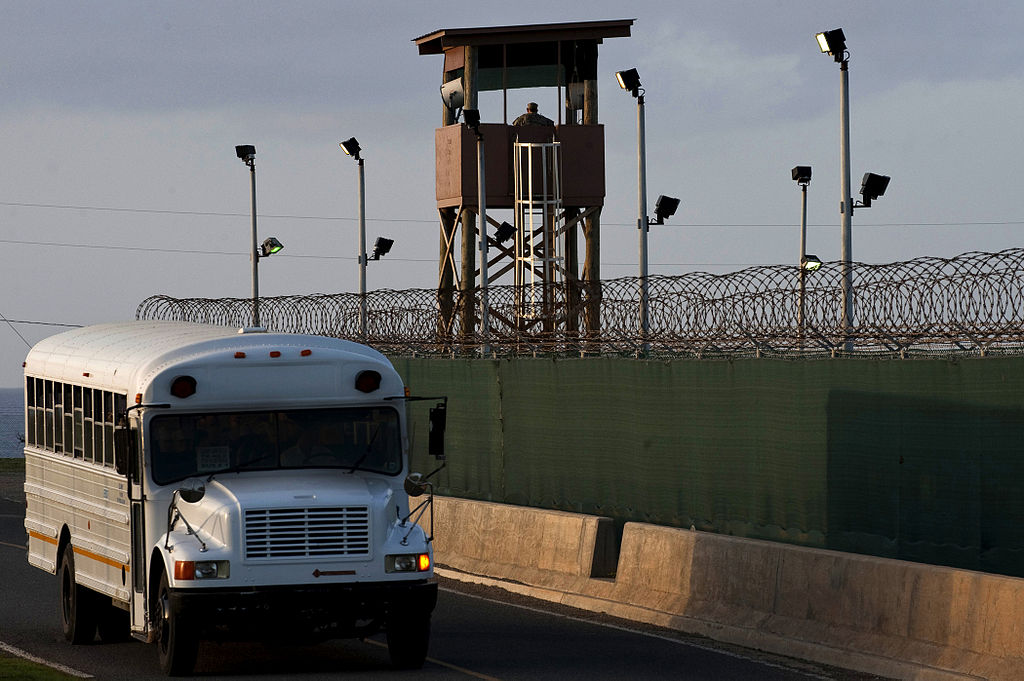This Week at the Military Commissions, 11/8-11/10: Pretrial Proceedings Continue (Part III)
Pretrial activities in United States v. al-Nashiri shifted focus Nov. 8 and 10, as the prosecution began presenting witnesses and physical evidence from the USS Cole for preadmission by presiding judge Col. Vance Spath. Judge Advocate General Lt. Alaric Piette represented al-Nashiri in the courtroom and continued to assert that the defense cannot proceed without death penalty counsel.

Published by The Lawfare Institute
in Cooperation With

Pretrial activities in United States v. al-Nashiri shifted focus Nov. 8 and 10, as the prosecution began presenting witnesses and physical evidence from the USS Cole for preadmission by presiding judge Col. Vance Spath. Judge Advocate General Lt. Alaric Piette represented al-Nashiri in the courtroom and continued to assert that the defense cannot proceed without death penalty counsel. Two other military attorneys detailed to the defense team, Maj. Brett Robinson and Maj. Kenitra Fewell, did not attend the sessions.
Al-Nashiri missed the Wednesday morning session due to a medical appointment, so first in the order of business was for the court to confirm that he voluntarily waived his right to be present. Managing Assistant Trial Counsel Col. John Wells called to the stand a staff judge advocate who spoke with al-Nashiri earlier in the morning and obtained a signed waiver form, which was entered into the record. Next, the court rehashed the issue of the civilian defense attorneys’ absence. Spath offered to give Piette time to introduce al-Nashiri to the new military attorneys assigned to the case. The judge emphasized that Piette was fully qualified to act on al-Nashiri’s behalf even without learned counsel present because “the simple direct and cross-examination of witnesses, fact witnesses and foundational witnesses . . . [is] the bread and butter of law practice[.]” The court, in Spath’s view, was not dealing “with matters that require capital qualification or capital experience at all[,]” so Piette’s refusal to participate was unwarranted. Piette responded that he was following the American Bar Association (ABA)’s guidelines for capital cases and that “bringing more unqualified counsel in isn’t going to change the fact that learned counsel isn’t giving us, or Mr. al[-]Nashiri, assistance and advice, which he statutorily has the right to have and needs to have[.]” Spath reminded the judge advocate general that the ABA guidelines are not mandatory, and commented that there is nothing about the current evidence preadmission process--in which the prosecution is presenting the foundation for its evidence, but Spath is delaying admission until it is presented in its entirety and the defense has the opportunity to rebut--that requires specialized death penalty expertise.
The judge then turned things over to lead prosecutor Mark Miller, who called five witnesses in succession: Aaron Morgan, retired Navy sailor and Cole crew member; Anthony Duback, FBI special agent; Paul Fennewald, retired FBI special agent; Robert Holley, retired FBI special agent and Michael Marks, retired Naval Criminal Investigative Service agent, via video teleconference (VTC). Miller first asked each witness about his professional background and his role in the investigation into the Cole attack, and then presented a series of exhibits for identification and preadmission as evidence. The exhibits included photographs of the Cole post-attack and the surrounding area; diagrams of the underwater search area around the ship; foreign debris, including fiberglass and wood shards, strips of wire, pieces of carpet, boat parts, and human remains; and samples of explosive residue that coated parts of the ship. For physical exhibits, the witnesses described the material, where and when it was found, how it was collected and processed, the chain of on-site custody, and the relevance of the material to the investigation. The government also entered into the record the law enforcement evidence tag information and tracking numbers, verified whether or not the handwriting and signature on the chain of custody forms was that of the witness, and asked if the witness had reason to believe the exhibit had been altered in any way since collection. After the prosecution finished questioning each witness, Spath gave the defense the opportunity to cross-examine; Piette declined in each case.
The court repeated the same process of evidence preadmission on Friday, with two more witnesses: retired FBI agents Morgan Bodie and Robert Mulry, the latter via VTC. Judge Spath also briefly addressed the effort to summon Ellen Yaroshefsky and Emily Olson-Gault to give testimony regarding the absence of learned death penalty counsel Rick Kammen. Olson-Gault agreed to appear via VTC Nov. 13, but Yaroshefsky filed a motion in the Southern District of New York to preemptively quash any possible forthcoming subpoena. The prosecution noted that it “remains confident that the federal courts reviewing these collateral attacks on the military commissions system will reach the conclusion . . . that the principles of comity, respect for the expertise of military judges and judicial economy, weigh against federal court intervention in pending . . . proceedings and in favor of requiring exhaustion of all available remedies within the military justice system before a federal court’s collateral review.” In his final comments, Spath reiterated that he would abide by any directives coming down from superior courts, but until then would continue with evidence preadmission and other routine matters. The court then went into recess until Nov. 13.



.jpg?sfvrsn=d5e57b75_5)

